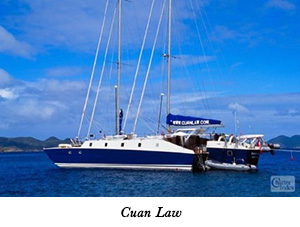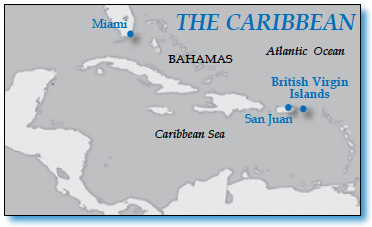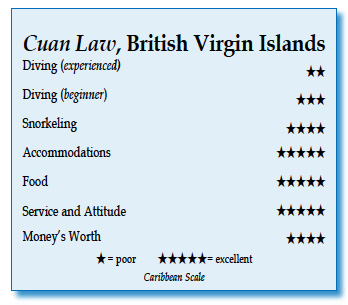Cuan Law, British Virgin IslandsContents of this Issue: XTC Dive Center, Xcalak, Mexico New Rules for Lithium-Ion Batteries on Airplanes Security Concerns for Diving in Malaysia Cuan Law, British Virgin Islands Hammerhead on the California Coast: “It Kept Coming At Me” Anything New at the DEMA Show? Getting Batteries for Old But Reliable Dive Computers Do Sport Divers Need a Spare Air? Carl Roessler, Steve Jobs and the “Maddened Attack” Editorial Office: Ben Davison Publisher and Editor Undercurrent 3020 Bridgeway, Suite 102 Sausalito, CA 94965 first-class trimaran and service, but the diving . . . from the November, 2015 issue of Undercurrent
Dear Fellow Diver: Right off the bat, I knew that a liveaboard trimaran that carries two Hobie cats, a kayak and water skis served a more diverse crowd than dedicated divers. I also recalled that my first dive trip to the British Virgin Islands produced gentle, if unspectacular, reef diving. Nevertheless, when a June group trip came along that allowed me to bring a few friends and family members who didn't dive, I signed up. After all, I can find an underwater subject for my camera anywhere, and the 105-foot Cuan Law sustains a fine reputation, having been in operation for nearly 30 years in these waters. Why not give it a go? After overnighting in San Juan, Puerto Rico, the Seaborne Airways flight to Tortola was aboard a Saab 340, meaning most carry-ons must be checked on the tarmac. I asked the gate agent for a fragile tag, as my carry-on contained my camera equipment. They handled it with great care, but not so for a friend whose carry-on was not tagged; somehow, the handle on the housing inside his carry-on was broken off. In Tortola, the Cuan Law sent a taxi to pick us up. Since it was a couple hours before our noon boarding time, we were dropped off at a market in Road Town to pass the time, while our bags were taken to the craft. After our shopping excursion, we were picked up for the short drive to the marina, where the owners, British expats Duncan and Annie Muirhead, and the full crew met us. The trimaran Cuan Law was designed and built in 1988 by the Muirheads, who reside in Tortola. In his mid-seventies, Duncan has a sincere smile and a pleasant wife about his age and half his size. Annie jumps right in to grab mooring ropes or do anything else that needs doing, and never hesitates to tell Duncan to get moving if need be. It was clear to me they have been working well together for a long time, with Annie at the helm.
She was a full boat -- 22 passengers, about 16 whom were beaucoup serious underwater photographers. That many were a bit overwhelming for even its fine crew. Half the dives were off the mother craft, because, with only one screw, it's not very maneuverable. For the other dives, two dinghies -- each 21 feet long with 115HP outboards -- carried eight divers each to the sites. On any given shuttle, there was between $50,000 and $75,000 of photographic hardware lying on the dinghy bottom (or clutched hard by the divers). Every last diver worried about who just might kick his beloved strobe, or how carefully the crew would pick up or put down his dual-strobed Nikon when the diver rolled off or climbed back in. The atmosphere was tense at times, but the crew handled it well. They were probably more used to a GoPro and a SeaLife rig or two, not the 16 professional set-ups on my trip. Our crew of seven was undoubtedly committed to doing a first-class job. And the boat itself? First class. At one end of the large, beautiful, air-conditioned main salon sat a well-stocked full bar (the rule: The first drink of the day comes after the last dive of the day). With comfortable leather chairs and couches, the salon became the spot for reviewing dive photos, planning the next dive, or just cooling off and avoiding the mid-day sun. Candy bars and chips were there for the taking. In the aft, the video room is well stocked with films, or you can look at your own videos of the day's dive. Although there is no such thing in my mind as a bad Caribbean dive, the lack of marine life and healthy corals was obvious in comparison to other Caribbean destinations like Turks & Caicos, Curacao or Bonaire. Visibility was compromised by mega suspension, likely due to the winds that blew several weeks longer than normal before we arrived. The result: Wide-angle shots looked like they were shot in a snowstorm. The reefs were OK, but corals were suffering and big fish missing, as they were when I dived here several years ago. Even the night dives were lacking. I see more in Curacao or Cozumel in two or three dives than in a week in BVI. Our best dive, regarding marine life, was the Aquarium, home to many typical reef fish (yellowtails, queen angels, drums, trunkfish, filefish, parrotfish, squirrelfish, durgons, triggerfish, trumpetfish, moray eels and lobster). On some dives, I did encounter turtles and stingrays, but nothing larger. On night dives, squid were abundant. We dived several small wrecks, which provided good background but not a lot of fish action, and, of course, the Rhone, made famous four decades ago in the film The Deep (remember Nick Nolte and Jacqueline Bisset?). It has since pancaked, and, while providing an interesting swim and good photo backgrounds, it had a disappointing lack of marine life. On one dive, the exciting event was photographing a French angel that had swum back and forth in front of me, probably as it does every time divers arrive. I should add that Jamie sported giant free diving fins, and, being that he was in excellent shape, free dives of two minutes or longer were no problem for him.
After the first day on the boat, I became aware that most of the crew including Chris, our Aussie captain with a "can do, will do" attitude, were as new to the Cuan Law as we were. Compensating for that was Scott, "the Admiral," who had captained the boat for many years. Whenever new crew comes on, Duncan calls in the Admiral from Miami, where he sells commercial real estate, to ensure everything is done to high standards, the Cuan Law way. One high standard was obviously the meals, served at mahogany tables on the open back deck. While breakfast and lunches were buffets, dinner was always a sit-down affair served by a crew member (the others joined our tables). Elegant meals were prepared by Sara, a four-star chef with exceptional experience; I would expect her to be working as head chef in a fine European restaurant, but she has partnered with the captain, a lucky man. We had fantastic seafood, excellent steaks (served with stuffed twice-baked potatoes and fresh vegetables), superb chicken and even roast duck, all served with the best wines and finished up with desserts, such as crème brulee with a raspberry coulis. For breakfast, Sara always offered plenty of fresh fruit, homemade breads, eggs and breakfast meats, and her lunches featured delicious fresh salads, wonderful sandwiches, maybe tacos or a pasta, and her special soups. Sara had snacks waiting after each dive and before dinner -- meatballs, shrimp or cheese pastries. After a quick nosh, I'd rinse my camera, then join other divers in the salon to download, critique and share our work, often with plenty of oohs and ahs. With many outlets for charging batteries and running iPads, we had no complaints.
It's a fine dive operation, with nitrox readily available. Gear is stowed under benches on the large back deck, wetsuits hung to dry and the crew helped divers suit up. Tank filling began immediately after each dive, so there were never delays. Diving from the mother boat was best started with a giant stride -- a five-foot drop -- or for those who insisted on walking with all their gear on, a few steps down to the swim platform. For dinghy diving, I suited up on deck and stepped into the dinghy in full gear, backrolling in at the dive site and scaling the easy ladder for re-entry. The BVIs are indeed picturesque and romantic, with 60 rock islands, densely covered with small trees and bushes, some with wild goats and nesting birds. One small island looks exactly like a lion, another like a pair of birds, and "the Baths" are a unique formation, with huge granite boulders, some 75 feet in diameter, pushed up by volcanoes millions of years ago. At the Baths, the crew fixed a BBQ lunch of hot dogs and hamburgers, with salads and fruit, under a beach palapa. Afterward, we climbed to the top of the island, weaving between giant boulders on the way. There we sat in a quaint open-air grill, enjoying a refreshing adult beverage and enjoying the view. Due to the proximity of the islands to each other, the boat only moves a couple of hours per day. Depending on the distance of the move and the direction of the prevailing wind, we would hoist the sails, shut down the engine and enjoy the peacefulness of being under sail. So while not all divers, especially non-photographers, will find the diving unique, everyone would enjoy the perfect accommodations, great crew, superb food and a wonderful, laid-back week of sailing (though the wind wasn't good for diving) in beautiful groups of islands. With five dives a day, the Cuan Law qualifies as a dedicated dive liveaboard, though the diving falls short. Still, it's a perfect venue for casual divers, newbies, diving families, and divers with non-diving, sun-loving partners. The trip offered plenty of opportunity for snorkeling, including the unique opportunity to snorkel the shallow end of the Rhone. Wreck diving is normally not available to snorkelers, but the Rhone is the exception. Everywhere we anchored offered a snorkeling opportunity and a chance to observe firsthand the marine life of BVI. My non-diving companions were sure happy campers. --J.P.W. Our undercover diver's bio: J.P.W. says, "I've made bubbles for more than 50 years, been a professional instructor for 46 years, got engaged to my bride of 35 years underwater in Cozumel, and certified three generations of my family. While I have never dived below the equator, I have dived the River Thames in the U.K., the West Coast of Scotland, Greece, Red Sea, Thailand, Truk Lagoon, Hawaii, Mexico, Aruba, Turks and Caicos, and the list goes on and on."
|

I want to get all the stories! Tell me how I can become an Undercurrent Online Member and get online access to all the articles of Undercurrent as well as thousands of first hand reports on dive operations world-wide
| Home | Online Members Area | My Account |
Login
|
Join
|
| Travel Index |
Dive Resort & Liveaboard Reviews
|
Featured Reports
|
Recent
Issues
|
Back Issues
|
|
Dive Gear
Index
|
Health/Safety Index
|
Environment & Misc.
Index
|
Seasonal Planner
|
Blogs
|
Free Articles
|
Book Picks
|
News
|
|
Special Offers
|
RSS
|
FAQ
|
About Us
|
Contact Us
|
Links
|
3020 Bridgeway, Ste 102, Sausalito, Ca 94965
All rights reserved.

 Upon arriving aboard, I took my
shoes and put them in a basket, only to
retrieve them upon departure -- a true
"barefoot cruise." Crew members Amy, tall
and bubbly, and Florrie, shorter and
equally pleasant, showed us our cabins
off the main salon. Roomy for liveaboard
cabins, they had either a full double
bed or two twins, AC, and a head with a
shower. Then it was a briefing on policy
and procedures, and within an hour after
boarding, we were off to the first dive
site. All divers, with the exception of
those with instructor credentials, met guides Jamie or Ben, both fullfledged
instructors, on the bottom
for a mask clear, regulator removal
and hand signal review. While divemasters
or crew were always in the
water, divers were free to do their
own thing as underwater photographers
prefer, some spending as much
as 90 minutes in the 80-degree-plus
water and nearly filling up their
chips.
Upon arriving aboard, I took my
shoes and put them in a basket, only to
retrieve them upon departure -- a true
"barefoot cruise." Crew members Amy, tall
and bubbly, and Florrie, shorter and
equally pleasant, showed us our cabins
off the main salon. Roomy for liveaboard
cabins, they had either a full double
bed or two twins, AC, and a head with a
shower. Then it was a briefing on policy
and procedures, and within an hour after
boarding, we were off to the first dive
site. All divers, with the exception of
those with instructor credentials, met guides Jamie or Ben, both fullfledged
instructors, on the bottom
for a mask clear, regulator removal
and hand signal review. While divemasters
or crew were always in the
water, divers were free to do their
own thing as underwater photographers
prefer, some spending as much
as 90 minutes in the 80-degree-plus
water and nearly filling up their
chips. But wait. Don't let my diving experience cancel the positive aspects, as
there were many. I made up for the mediocre diving by enjoying the full Cuan
Law experience. The hospitality, accommodations, food, drinks and the crew were
top shelf. (A caveat: If you are a single or a couple spending a week on this boat without a group of friends, the camaraderie may not be what I had. Groups
always provide entertainment and give color to a trip. Groups are usually fun,
no matter how dull the diving.)
But wait. Don't let my diving experience cancel the positive aspects, as
there were many. I made up for the mediocre diving by enjoying the full Cuan
Law experience. The hospitality, accommodations, food, drinks and the crew were
top shelf. (A caveat: If you are a single or a couple spending a week on this boat without a group of friends, the camaraderie may not be what I had. Groups
always provide entertainment and give color to a trip. Groups are usually fun,
no matter how dull the diving.) For many divers, five dives a day
in these waters would be too much. If
you're one of them, or if you have a
non-diving partner, there was plenty of
time to snorkel, try a Hobie Cat, paddle
a kayak, lounge on a float or sunbathe
on the massive deck. Due to the winds
during my week, the standard position
on the sundeck was one hand on the rail
and the other on your hat, which became
known as "the position," which one often
assumed upon arriving on the deck.
For many divers, five dives a day
in these waters would be too much. If
you're one of them, or if you have a
non-diving partner, there was plenty of
time to snorkel, try a Hobie Cat, paddle
a kayak, lounge on a float or sunbathe
on the massive deck. Due to the winds
during my week, the standard position
on the sundeck was one hand on the rail
and the other on your hat, which became
known as "the position," which one often
assumed upon arriving on the deck. Divers Compass: The 2016 rate for a seven-day trip is $2,795 per person, which
includes beer, wines, top-shelf liquor and all the diving . . .
Nitrox is $10 per tank or $120 for the week, and tanks are aluminum
63s, 80s, or 100s . . . Regulators with pressure and depth
gauges rent for $50 per week and BCs for $40 per week; both can
be rented for $15 per day, and snorkeling equipment is gratis .
. . You can reach Tortola through either San Juan or St. Thomas,
although the latter gives you an option of air or ferry boat;
though both are U.S. territories, you still must pass through
customs, and of course, you need a passport to enter the BVIs .
. . My trip required an overnight in San Juan, so after checking
into our hotel around 1 p.m., four of us tried the InterContinental Hotel for
a quick lunch -- two sandwiches, a beer, an order of chicken wings and a salad
cost us $150! . . . Website -
Divers Compass: The 2016 rate for a seven-day trip is $2,795 per person, which
includes beer, wines, top-shelf liquor and all the diving . . .
Nitrox is $10 per tank or $120 for the week, and tanks are aluminum
63s, 80s, or 100s . . . Regulators with pressure and depth
gauges rent for $50 per week and BCs for $40 per week; both can
be rented for $15 per day, and snorkeling equipment is gratis .
. . You can reach Tortola through either San Juan or St. Thomas,
although the latter gives you an option of air or ferry boat;
though both are U.S. territories, you still must pass through
customs, and of course, you need a passport to enter the BVIs .
. . My trip required an overnight in San Juan, so after checking
into our hotel around 1 p.m., four of us tried the InterContinental Hotel for
a quick lunch -- two sandwiches, a beer, an order of chicken wings and a salad
cost us $150! . . . Website - 